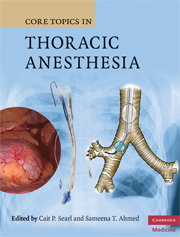
-
Select format
-
- Publisher:
- Cambridge University Press
- Publication date:
- December 2009
- April 2009
- ISBN:
- 9780511576683
- 9780521867122
- Dimensions:
- (246 x 189 mm)
- Weight & Pages:
- 0.67kg, 230 Pages
- Dimensions:
- Weight & Pages:
You may already have access via personal or institutional login
Book description
Providing an easily readable source of information about the current spectrum of anesthesia and critical care management of patients undergoing thoracic surgery, this book forms part of the successful Core Topics brand. The book provides practical assistance to those commencing careers in thoracic anesthesia and will also to be a useful aide-memoire to those already working in the field. The comprehensive content includes discussion of some of the more contentious issues in the management of thoracic patients as well as giving a flavour of the rapid evolution of new techniques that are of increasing importance in the field, such as lung-assist devices, different modes of ventilation and VAT surgery. Both editors are practising cardiothoracic anesthetists/intensivists at an internationally recognized centre for thoracic surgery, particularly lung transplantation. The contributors are chosen for their clinical expertise and to give a spectrum of opinion across the range of thoracic anesthesia.
Reviews
'… can be recommended for trainees in thoracic anaesthesia, and it would be a useful, concise reference for the occasional thoracic case presenting to the specialist.'
Source: Anaesthesia and Intensive Care
'… concise but comprehensive … All anaesthesia providers in the field will find this valuable for their daily practice and preparation for examinations.'
Source: Doody's
Contents
Metrics
Full text views
Full text views help Loading metrics...
Loading metrics...
* Views captured on Cambridge Core between #date#. This data will be updated every 24 hours.
Usage data cannot currently be displayed.
Accessibility standard: Unknown
Why this information is here
This section outlines the accessibility features of this content - including support for screen readers, full keyboard navigation and high-contrast display options. This may not be relevant for you.
Accessibility Information
Accessibility compliance for the PDF of this book is currently unknown and may be updated in the future.


